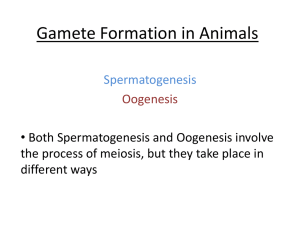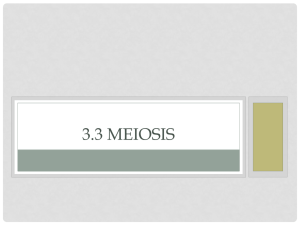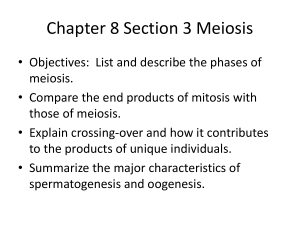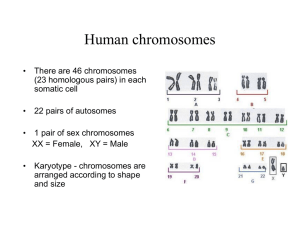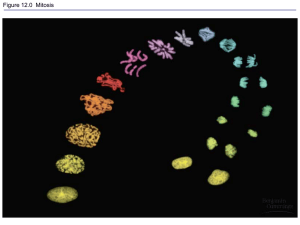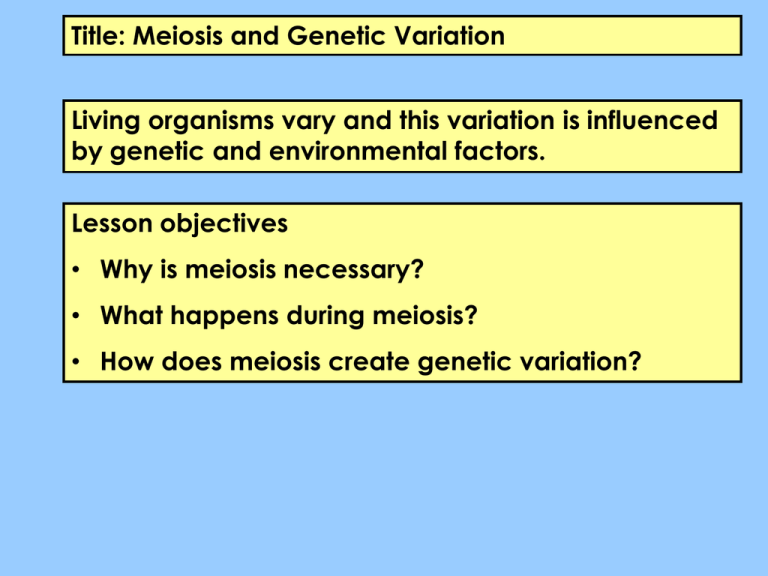
Title: Meiosis and Genetic Variation
Living organisms vary and this variation is influenced
by genetic and environmental factors.
Lesson objectives
• Why is meiosis necessary?
• What happens during meiosis?
• How does meiosis create genetic variation?
Mitosis recap
Do Now…….!
Complete the card sort –
which statement belongs
to mitosis and which to
meiosis (this is GCSE
revision….!)
Chromosome number
A human somatic (body) cell
contains 46 chromosomes.
These consist of 23 pairs of
homologous chromosomes.
Each pair contains one
chromosome from each
parent. Other species
have different numbers of
these homologous pairs.
Sex cells, or gametes, have only one copy of each
chromosome: they are haploid. A somatic cell, containing
two of each, is called diploid.
4 of 32
© Boardworks Ltd 2008
Haploid gametes
All somatic cells in a multicellular organism are genetically
identical because they are the result of mitosis.
They are all descended from a single cell – a zygote.
A zygote is formed when
two haploid gametes fuse.
These gametes are
genetically unique
because, unlike somatic
cells, they were formed by
a special form of cell
division called meiosis.
5 of 32
© Boardworks Ltd 2008
Meiosis I and II
Meiosis is the process of cell division underlying sexual
reproduction. It is a two-stage process:
Meiosis I introduces genetic
diversity by randomly dividing
a cell’s genes in two. It results
in two haploid cells.
Meiosis II is similar to mitosis. It
splits each chromosome into its
two chromatids and places one
in each daughter cell. It results in
four haploid gametes.
6 of 32
© Boardworks Ltd 2008
Genetic variation
Sexual reproduction creates
genetic diversity within a
population, which is vital to
a species’ survival.
Two processes during
meiosis determine the
unique genetic make-up
of the four daughter cells:
During meiosis I, homologous pairs of chromosomes swap
parts of their genetic material. This is crossing over.
The chromosomes from each pair are randomly allotted to
the daughter cells by independent assortment.
7 of 32
© Boardworks Ltd 2008
Task 1
Using your laptops and textbooks, you should
research the following objective – ‘Why is meiosis
necessary?’
You should produce at least one side of A4 in answering the
question and include clear definitions of the following words –
Diploid, haploid and explain the chromosome number
(humans)
Meiosis
9 of 32
© Boardworks Ltd 2008
Task 2
Using an A3 sheet of paper (in pairs), you should
produce an overview of the process of meiosis. This
should include diagrams and be clearly annotated –
you may want to include a separate information
sheet if this is easier.
(It should include Meiosis 1 and meiosis 2)
Meiosis: true or false?
11 of 32
© Boardworks Ltd 2008
Variation from meiosis
12 of 32
© Boardworks Ltd 2008
Chromosome mutations
13 of 32
© Boardworks Ltd 2008
Task 3
How does meiosis create genetic variation?
You should explain the process of independent segregation
and illustrate it with an example (pg 142 has an example, but
you should find another).
You also need to explain the process of recombination by
crossing over.
Glossary
15 of 32
© Boardworks Ltd 2008
What’s the keyword?
16 of 32
© Boardworks Ltd 2008
Mitosis and meiosis
17 of 32
© Boardworks Ltd 2008
Task 4
Comparison of mitosis and meiosis
Complete the worksheet – you must know this inside out!!!!!!
Plenary
Complete the exam style questions from the
textbook, pg 144-145
Multiple-choice quiz
19 of 32
© Boardworks Ltd 2008


